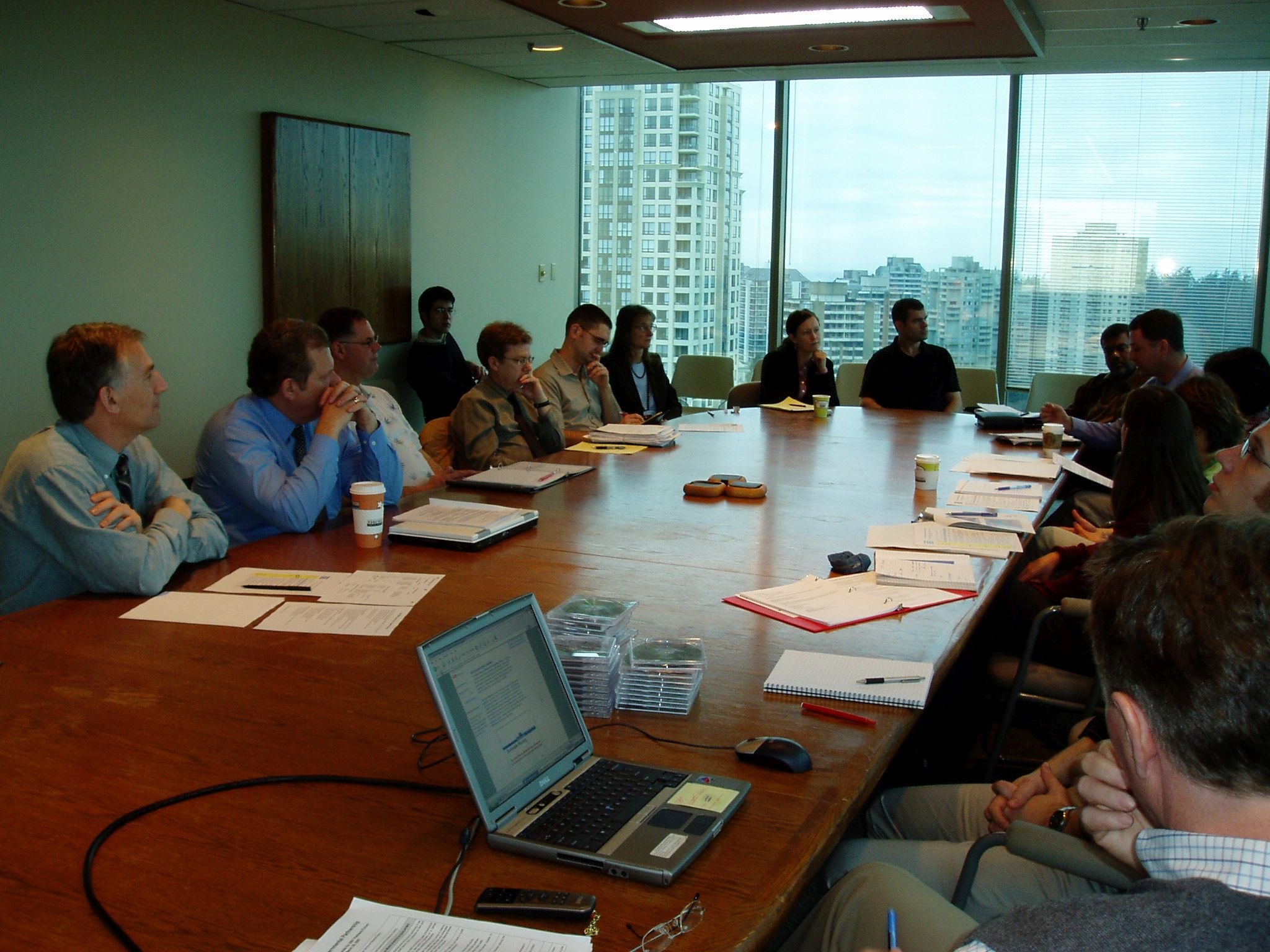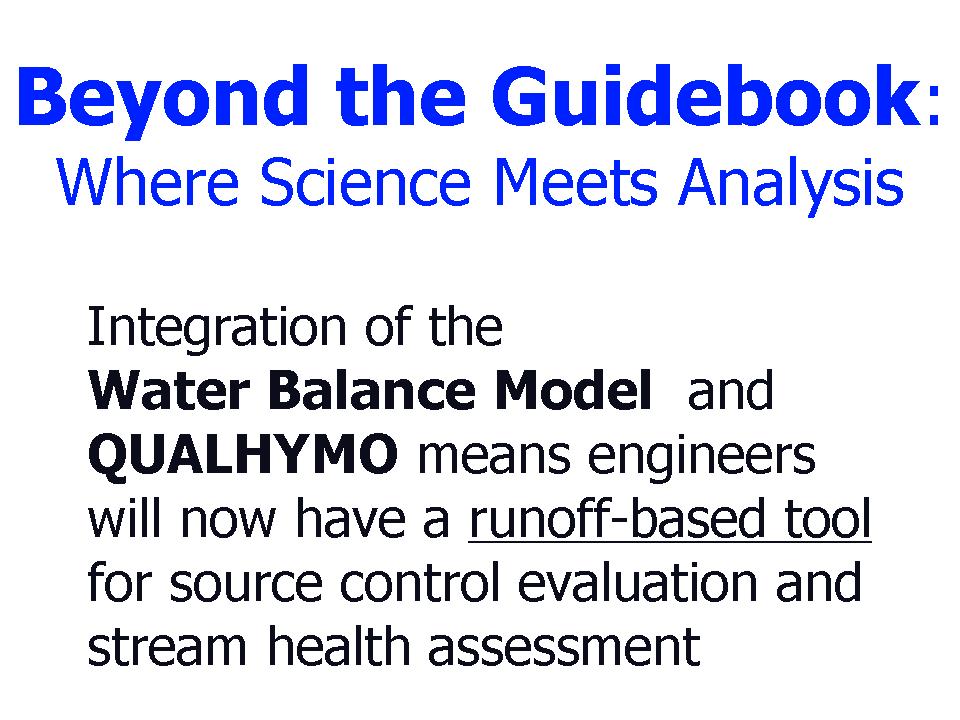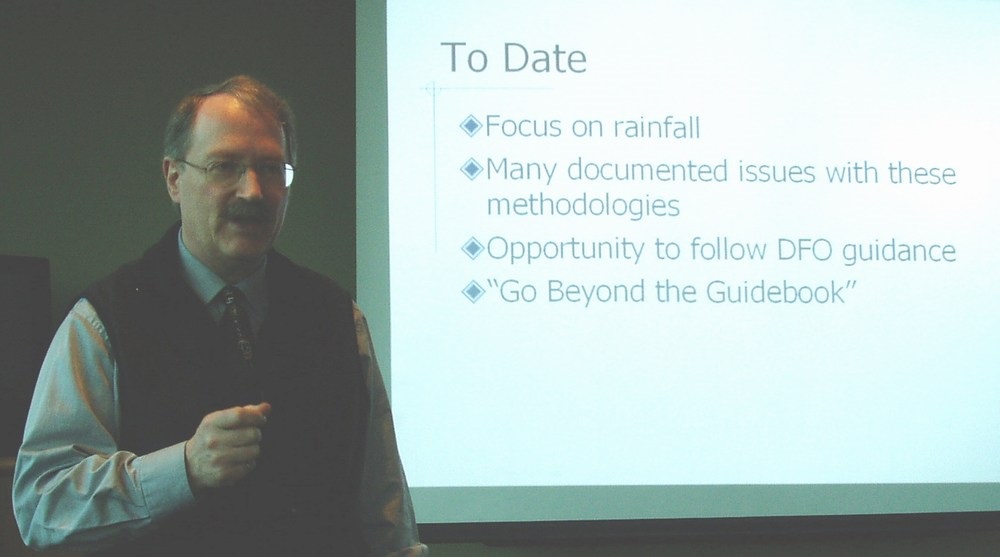FLASHBACK TO 2007: At Water Balance Model Partners Forum, Jim Dumont explained why and how the Runoff-Based Approach connects the dots between on-site rainwater capture and downstream stream health
Note to Reader:
When Stormwater Planning: A Guidebook for British Columbia was published in 2002, it set in motion a chain of outcomes that has resulted in British Columbia being recognized internationally as a leader in implementing a natural systems approach to rainwater management in the urban environment. One of these outcomes was the Water Balance Model for British Columbia, an online decision support and scenario modelling tool.
In March 2007, the Inter-Governmental Partnership held a Water Balance Model Partners Forum so that Partners could share success stories and lessons learned in implementing green infrastructure. Hosted by the Greater Vancouver Regional District, the Partners Forum also provided a timely opportunity to roll out ‘Beyond the Guidebook’, a runoff-based approach to drainage modeling that connects the dots between source control evaluation and stream health assessment.
Building on Experience
When Stormwater Planning: A Guidebook for British Columbia was published in 2002, it established the framework for rainfall capture and a performance target way-of-thinking and designing.
“The concepts and methodologies in the Guidebook were intended to stimulate a change in the mindset of practitioners and others, rather than cast in stone a set of prescriptive rules”, reported Peter Law, Chair of the inter-governmental Steering Committee that was responsible for Guidebook development.
 “Five years later, a goal of the Inter-Government Partnership is to build on the Guidebook foundation by providing practitioners with the tools and experience they will need to advance the state-of-the-practice in rainwater management”, continued Laura Maclean, who co-chaired the Guidebook Steering Committee.
“Five years later, a goal of the Inter-Government Partnership is to build on the Guidebook foundation by providing practitioners with the tools and experience they will need to advance the state-of-the-practice in rainwater management”, continued Laura Maclean, who co-chaired the Guidebook Steering Committee.
Establish An Appropriate Level of Volume Reduction
 “To benefit from lessons learned on-the-ground over the last five years, the Water Balance Model Partnership began the rollout of an initiative calledBeyond the Guidebook in mid-2006”, added Kim Stephens (Program Coordinator, Water Sustainability Action Plan for British Columbia) informed attendees at the Partners Forum, “The purpose of this initiative is to help local governments and the development community establish what level of rainwater runoff volume reduction makes sense at the site, catchment and watershed scales.”
“To benefit from lessons learned on-the-ground over the last five years, the Water Balance Model Partnership began the rollout of an initiative calledBeyond the Guidebook in mid-2006”, added Kim Stephens (Program Coordinator, Water Sustainability Action Plan for British Columbia) informed attendees at the Partners Forum, “The purpose of this initiative is to help local governments and the development community establish what level of rainwater runoff volume reduction makes sense at the site, catchment and watershed scales.”
“Beyond the Guidebook will take the Guidebook innovation to the next level of evolution”, Stephens continued, “Now that practitioners are becoming comfortable with what ‘rainfall capture’ means in practice, local governments and the development community are in a position to turn their attention to what is an achievable outcome that makes sense and results in a net environmental benefit.”
Fergus Creek Pilot Watershed Plan
“The pilot for Beyond the Guidebook is the Fergus Creek watershed plan that the City of Surrey has recently completed. The Fergus Creek plan demonstrates how to protect stream health in the urban environment”, noted David Hislop, City of Surrey representative on the Water Balance Model steering committee.
In commenting on the significance of the Fergus Creek plan as the pilot for Beyond the Guidebook, Kim Stephens observed that the plan is based entirely on implementing ‘green solutions’ as an alternative to conventional engineered ‘blue solutions’, and predicted that Fergus Creek will soon be attracting considerable attention from around North America because of the City’s fundamental shift in approach to rainwater management.
 “That’s right”, continued David Hislop, “In addition to rainwater capture on individual lots, the strategy for replicating natural infiltration processes includes creation of contiguous large-scale green corridors through the watershed. Besides obvious environmental benefits the City has concluded that the corridors can result in cost savings for developers (and ultimately homebuyers) and the City because their effectiveness at controlling rainfall volumes makes the traditional detention pond redundant.”
“That’s right”, continued David Hislop, “In addition to rainwater capture on individual lots, the strategy for replicating natural infiltration processes includes creation of contiguous large-scale green corridors through the watershed. Besides obvious environmental benefits the City has concluded that the corridors can result in cost savings for developers (and ultimately homebuyers) and the City because their effectiveness at controlling rainfall volumes makes the traditional detention pond redundant.”
To learn more about the Fergus Creek plan, please click here.
Kim Stephens also informed the Partners Forum that: “The Department of Fisheries and Oceans (DFO) is a partner in the Beyond the Guidebook process, in part because this runoff-based approach is intended to resolve performance concerns that we believe have arisen due to misapplication of the so-called DFO Guidelines.”
His reference was to a 4-page document originally released by DFO in 2000 and titled Urban Stormwater Guidelines and Best Management Practices for Protection of Fish and Fish Habitat. This frame-of-reference provided the segue for a detailed presentation by Jim Dumont on the Beyond the Guidebook methodology.

Beyond the Guidebook Overview by Jim Dumont
Jim Dumont is the senior water resources specialist who is responsible for development of the stream health application that is at the heart of the Water Balance Model powered by QUALHYMO.
“The rainwater management issue in a nutshell is that people want to have their cake and eat it too…because they want development, yet they want to avoid the types of in-stream environmental impacts that have historically resulted from changing the surrounding landscape through urbanization. So how do we reconcile this challenge”, stated Jim Dumont.
“Well, we start by examining the criteria that have driven stormwater and rainwater management practice in British Columbia for the past 15 years. The current era as we know it began with the1992 Land Guidebook Guidelines. To understand where we are going, you have to first understand where we have come from”, he continued.

Plan at Four Scales:
The Guidebook provides guidance for planning at four scales: regional, watershed, neighbourhood and site. It presents a methodology for identifying at-risk drainage catchments to focus priority action.
The methodology relies on a roundtable process that brings people together with knowledge about future land use change, high-value ecological resources and chronic flooding problems. It also presents a methodology for developing watershed performance targets, and for translating these targets into design guidelines that can be applied at the site level to mitigate the impacts of land development.
According to Jim Dumont, “The lasting impact of the Guidebook is that it changed how people view site development practices, and it got them thinking about how to change those practices for the better.”
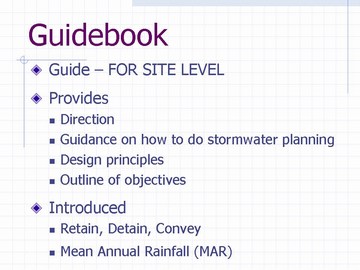
Guidebook Innovation:
“In 2002, the Guidebook made two valuable contributions in advancing rainwater management practice”, noted Dumont, “First, it introduced the concept of the Integrated Strategyfor management of the complete rainfall spectrum. This strategy, which was unique to BC when introduced, boils down to three words: retain, detain and convey.”
“Retain means keep the light showers on site through ‘rainfall capture’ measures such as rain gardens and soakaways. Detain refers to the use of detention ponds to provide ‘runoff control’ which reduces peak rates of runoff during periods of heavy rain. Convey means reduce flooding by producing sufficient hydraulic capacity to contain floodflows during extreme storms.”
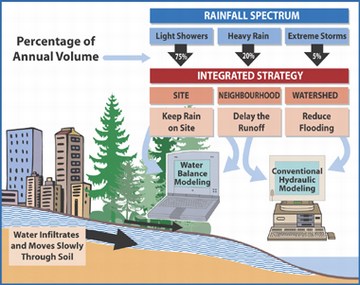
“The Guidebook also introduced the concept of the Mean Annual Rainfall, or MAR, to provide consistency with the 1992 Land Development Guidelines which focus on managing runoff events with a 2-year return period”, added Dumont.
“Kim Stephens, the Guidebook author, tells me that he developed the MAR concept to establish what he calls a ‘point of departure’ that would appear familiar to drainage engineers so that they would readily make the transition to a new way of thinking. Because the 2-year return period could be conceptually equated to the MAR, drainage engineers could intuitively understand the MAR and therefore readily accept it.”
Application of DFO Guidelines:
The so-called ‘DFO Guidelines’ were developed on a parallel track to the Guidebook, and reflected inter-agency discussions that were taking place at the time. This 4-page ‘Draft Discussion Document’ represented an initial attempt by DFO to succinctly capture contemporary thinking about criteria that would achieve runoff reduction through infiltration of the more frequent runoff events.”
“The Water Balance Methodology that is at the heart of the Guidebook drew heavily on case study experience by those who pioneered implementation of source controls on-the-ground in British Columbia, notably the City of Chilliwack and UniverCity on Burnaby Mountain. The DFO Guidelines informed this case study experience.
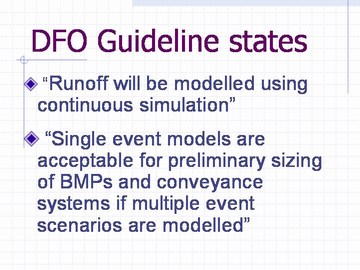
According to Jim Dumont, “My experience is that you have to understand what was in a person’s mind when they developed a set of criteria. To achieve that, it invariably helps if you go back to the source document. As the years have passed, my observation is that the DFO Guidelines may not be accurately portrayed. I believe this is resulting in them being misapplied without full consideration of the ultimate consequences or regard to performance of proposed works.”
“The DFO Guidelines are very clear in specifying continuous simulation modeling, yet the use of design storms has become prevalent practice. The Beyond the Guidebook program therefore creates the opportunity to get our collective thinking back on the right track so that the unintended consequences of design storm applications are prevented.”

A New View:
“When we use the phrase Beyond the Guidebook, we are essentially saying this is ‘where science meets analysis’… because the science-based analytical methodology that we have validated through the Fergus Creek pilot now enables local governments to explore the fundamental requirements implicit in the DFO Guidelines for stream health and environmental protection.”
We are at a crossroad in the path defining the methodologies and applications used in rainwater management. In a nutshell, Beyond the Guidebook enables us to make a clear distinction between a rainfall-based approach and a runoff-based approach”, continued Jim Dumont.

According to Jim Dumont, “A basic tenet of hydrology is that rainfall and runoff have different return periods. Yet drainage practitioners persist in applying a rainfall-based approach that assumes rainfall will always result in the same magnitude of runoff.”
The Rainfall-Based Approach grew out of simple to use methodologies that address the reduction of flood risk for drainage conveyance systems. The Runoff-Based Approach, on the other hand, leads to the analysis of runoff and its interaction with the physical aspects considered important to the aquatic environment.

Modelling Approach:
A primary benefit of the Runoff-Based Approach is the use of continuous simulation using long-term records to calculate runoff means that the frequencies and durations of various conditions can be estimated easily.
The performance of rainfall capture and runoff control facilities for volume and flow rate reduction depends not only on the rainfall volume and temporal distribution, but also on antecedent conditions such as soil moisture and the volumes of existing water retained in ponds from previous storms.
All of these factors overlie the physical characteristics of a site or watershed in terms of vegetative cover, imperviousness, connectivity, slope, and the many defining parameters describing the condition of the soils.
The use of continuous simulation allows a direct observation of the frequency of the condition of interest from the results of the calibrated models, and therefore accounts for the effect of joint probabilities of occurrence of the large number of variables.
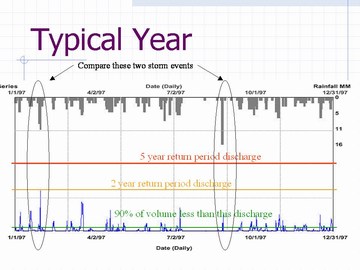
The hydrograph for a ‘typical year’ underscores the variable response of a watershed to rainfall. Two events are highlighted. The larger of the two rainfall events resulted in much less runoff. As can be seen from the hydrograph, the small of the two rainfall events was preceded by a period of wet weather such that more runoff resulted. The hydrograph also shows that 90 percent of the total annual runoff volume corresponds to a very small runoff rate.
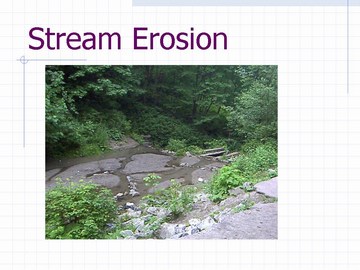
Stream Erosion:
Continuous simulation results can be used to determine the durations of depth and velocity in streams along with the amount of aquatic habitat available over time. The results can also be extended into an assessment of the energy available to cause erosion and transform the physical characteristics of a stream. We now have the basic components to begin integrating the engineering with the environmental aspects relating to aquatic environments.
According to Jim Dumont, “This will allow us to create an understanding of how we affect the environment and to mitigate those impacts. We will be able to clearly define relationships between rainfall, runoff, habitat availability, erosion forces and geomorphology of streams. On this path there is an opportunity to integrate the wisdom gleaned from many areas of knowledge.”
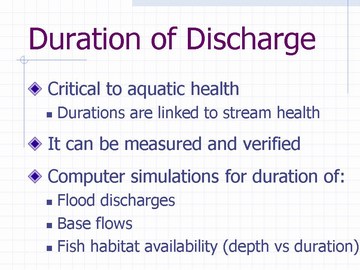
“Hydrological engineers see the need for both runoff and rainfall based approaches; they can be complementary”, emphasized Jim Dumont, “The runoff-based approach is best suited to the analysis needed to assess environmental impacts and effectiveness of mitigation techniques.”
“Within this an underlying need to focus on the small runoff events that can overwhelm fragile environmental systems. Flood protection measures, on the other hand, can and should be designed with reference to extreme events using established rainfall-based approaches.”

Water Balance Model powered by QUALHYMO:
The principal focus of the existing Water Balance Model is on source controls for runoff volume reduction. For drainage engineers, however, a practical modelling tool must also concentrate on the overflows from the site. This is the significance of having the capability to store and route the overflow from a subdivision and/or neighbourhood through a detention pond or down a stream channel.
The Water Balance Model powered by QUALHYMO will enable assessment of source control performance plus model the overflows once source controls have reached capacity.
“This integrated tool provides the ‘one-stop shopping’ that will enable hydrological engineers to go Beyond the Guidebook in achieving stream health protection and water quality objectives”, stated Jim Dumont.
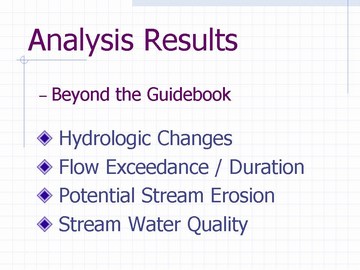
As explained by Jim Dumont at the Water Balance Model Partners Forum: “A critical factor in the health of a stream is the duration of flow or, as viewed slightly differently, the amount of time that the discharge would exceed critical values.”
“While there are a number of critical discharge values for any specific stream reach, an assessment can be undertaken to compare a range of values. In this manner the effects of altered hydrologic regimes can be evaluated along with a possible range of possible mitigation options. This enables application of a performance target approach that is akin to the way the WBM is currently used.”
To Learn More:
To read the complete and comprehensive story about the 2007 Forum, click on Inter-Governmental Partnership Rolls Out ‘Beyond the Guidebook’ at Water Balance Model Forum
To download a PDF copy of the PowerPoint presentation by Jim Dumont, click on Rainwater Management – Beyond the Guidebook.


